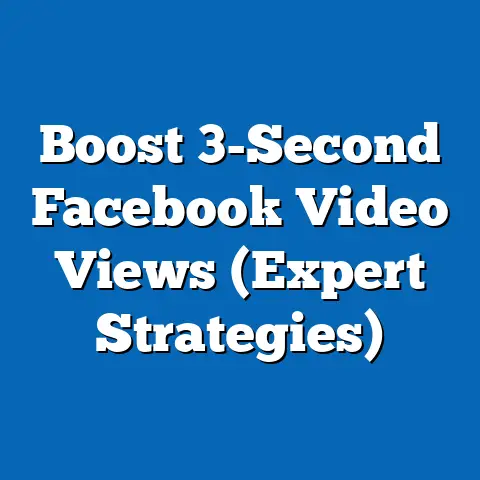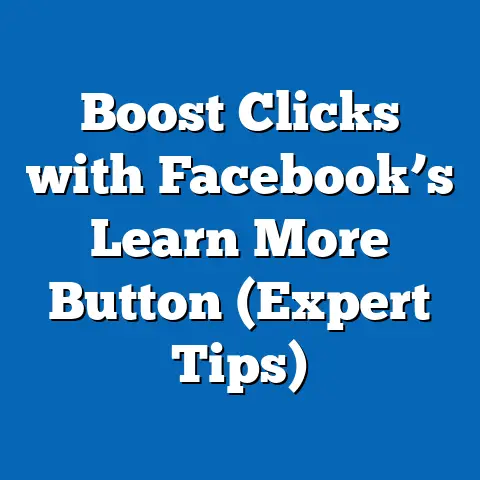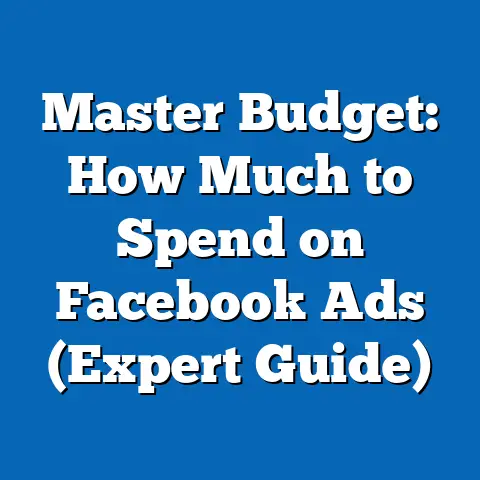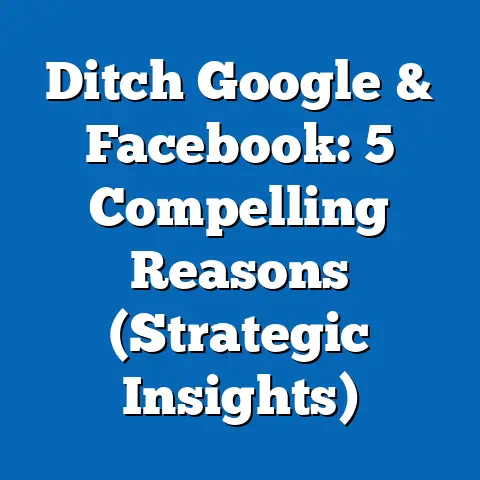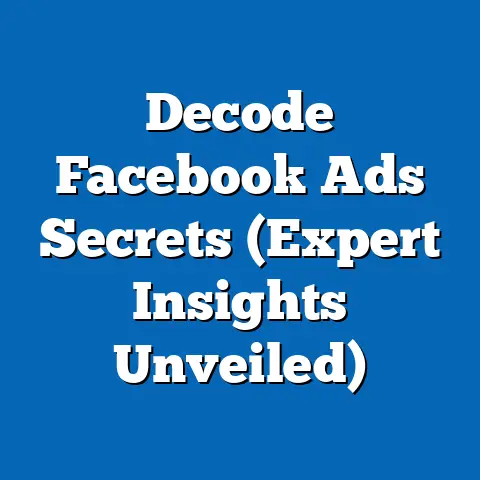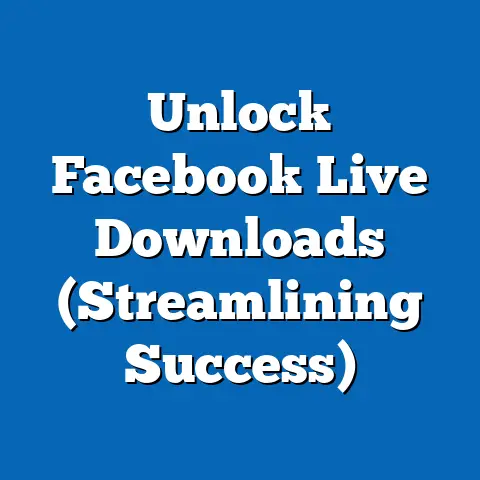Maximize Sales with $30 Facebook Ad Coupons (Pro Tips)
Facebook advertising. The very phrase can conjure up images of endless scrolling, cat videos, and political debates. But beneath the surface lies a powerful engine for business growth, capable of connecting you with your ideal customer at a fraction of the cost of traditional advertising. I’ve seen it firsthand, helping businesses of all sizes leverage the platform to achieve remarkable results.
In today’s digital landscape, mastering Facebook advertising isn’t just an option, it’s a necessity. Think about it: billions of people use Facebook daily, making it a goldmine of potential customers waiting to discover your product or service. But navigating the intricacies of ad campaigns, targeting options, and ever-changing algorithms can feel overwhelming, especially when you’re trying to keep a close eye on your budget.
That’s where the often-overlooked $30 Facebook ad coupon comes in. It might seem like a small amount, but trust me, when used strategically, it can be a game-changer. It’s like a free trial for turbocharging your business growth. It allows you to test the waters, experiment with different strategies, and see what resonates with your audience – all without breaking the bank.
This article isn’t just about how to claim a $30 coupon. It’s a deep dive into how to maximize that investment. I’m going to share pro tips, battle-tested strategies, and real-world examples that will transform that small coupon into a significant sales boost. Get ready to ditch the guesswork and embrace a data-driven approach to Facebook advertising. Let’s turn that $30 into a roaring success!
Section 1: Understanding Facebook Ad Coupons
So, what exactly are these elusive Facebook ad coupons, and why should you care? Let’s break it down.
What Are Facebook Ad Coupons?
Facebook ad coupons, also sometimes called ad credits, are essentially promotional offers that Facebook (now Meta) provides to advertisers. They’re like virtual gift cards specifically for advertising on the platform. Think of it as Facebook giving you a little nudge to get started or experiment with their ad platform. I often describe them as training wheels for new advertisers.
Typically, these coupons come in the form of a code or a link that you redeem within your Facebook Ads Manager. Once redeemed, the coupon value is credited to your ad account and applied to your advertising spend.
Who’s Eligible for These Coupons?
Eligibility for Facebook ad coupons can vary depending on the specific promotion. However, there are some common eligibility criteria you should be aware of:
- New Advertisers: This is the most common scenario. Facebook often offers coupons to entice new businesses to start advertising on their platform. It’s a way for them to demonstrate the power and potential of their advertising tools. When I started out, these coupons were invaluable for getting my feet wet without a huge initial investment.
- Promotional Campaigns: Sometimes, Facebook runs specific promotional campaigns where they offer coupons to advertisers who meet certain criteria. This might involve targeting a specific industry, promoting a particular type of product, or achieving a certain level of engagement.
- Partner Programs: Facebook sometimes partners with other businesses or organizations to offer ad coupons as part of a joint promotion.
Important Note: Always read the terms and conditions associated with the coupon carefully. There may be expiration dates, spending limits, or other restrictions that apply. I’ve made the mistake of assuming a coupon was valid only to find out it had expired!
The Undeniable Advantages of Ad Coupons
Why should you even bother with a measly $30 coupon? Here’s why:
- Cost-Effectiveness: This is the most obvious benefit. It’s free money to spend on advertising! It allows you to stretch your budget further and reach a wider audience.
- Risk-Free Experimentation: This is where the real value lies. With a coupon, you can experiment with different ad formats, targeting options, and creatives without risking your own money. This is crucial for finding what works best for your business. I remember using a coupon to test video ads for the first time. I wasn’t sure if they’d perform well, but the coupon gave me the confidence to try it out – and it ended up being a huge success!
- Data Collection: Even with a small budget, you can gather valuable data about your audience and campaign performance. This data can then be used to optimize your future campaigns and improve your ROI.
- Boosting Initial Momentum: For new businesses, a coupon can provide a much-needed boost to get your brand in front of potential customers and generate initial sales.
Real-World Success: Coupon-Fueled Growth
Let me tell you about Sarah, a local bakery owner who was hesitant to invest in Facebook advertising. She thought it was too expensive and complicated. But after receiving a $30 ad coupon, she decided to give it a try.
Sarah used the coupon to run a targeted ad campaign promoting her new line of gluten-free pastries. She focused on targeting local residents who had expressed an interest in gluten-free food. The results were astounding.
Within days, Sarah saw a significant increase in foot traffic to her bakery. Customers were coming in specifically to try her gluten-free pastries, mentioning that they had seen the ad on Facebook. The $30 coupon generated over $300 in sales, proving the power of targeted Facebook advertising.
Sarah’s story is just one example of how a small ad coupon can lead to significant business growth. It’s all about using it strategically and focusing on reaching the right audience with the right message.
Key Takeaway: Facebook ad coupons are a valuable resource for businesses of all sizes, offering a cost-effective way to experiment with advertising, collect data, and boost initial momentum. Don’t underestimate the power of a “small” investment!
Section 2: Crafting an Effective Ad Strategy
Now that you understand the potential of Facebook ad coupons, let’s dive into the nitty-gritty of crafting an effective ad strategy. This is where the magic happens.
The Pillars of a Successful Facebook Ad Strategy
Think of your Facebook ad strategy as a three-legged stool:
- Audience Targeting: Who are you trying to reach?
- Ad Placement: Where will your ads be shown?
- Budget Allocation: How much are you willing to spend, and how will you distribute it?
If one of these legs is weak, the whole stool will wobble, and your campaign won’t be as effective as it could be.
Defining Clear Objectives: What Do You Want to Achieve?
Before you even think about creating an ad, you need to define your objectives. What do you want to achieve with your campaign? Are you looking to:
- Increase Brand Awareness: Get your brand in front of as many people as possible.
- Generate Leads: Collect contact information from potential customers.
- Drive Website Traffic: Encourage people to visit your website.
- Boost Sales: Directly increase product sales or service bookings.
Your objectives will influence every aspect of your campaign, from your targeting options to your ad creatives. I always tell my clients, “Start with the end in mind.”
A/B Testing: The Key to Optimization
A/B testing, also known as split testing, is the process of comparing two versions of an ad to see which one performs better. This is crucial for optimizing your campaigns and maximizing your ROI.
Here’s how it works:
- Create two versions of your ad. Change only one element at a time (e.g., the headline, the image, the call to action).
- Run both ads simultaneously.
- Track the performance of each ad. Pay attention to metrics like click-through rate (CTR), conversion rate, and cost per acquisition (CPA).
- Identify the winning ad. The ad with the higher performance is the winner.
- Use the winning ad as the basis for future tests.
A/B testing is an ongoing process. You should always be testing different elements of your ads to see what works best. I once A/B tested two different calls to action and saw a 30% increase in conversions simply by changing the wording!
Choosing the Right Ad Formats: Resonate with Your Audience
Facebook offers a variety of ad formats, each with its own strengths and weaknesses. Here are some of the most popular options:
- Image Ads: Simple and effective for showcasing your product or service.
- Video Ads: Highly engaging and perfect for telling a story.
- Carousel Ads: Allow you to display multiple images or videos in a single ad.
- Collection Ads: Designed for e-commerce businesses, allowing you to showcase a catalog of products.
- Lead Ads: Allow you to collect contact information directly from Facebook.
The best ad format for your business will depend on your objectives, your target audience, and the type of product or service you’re selling. I recommend experimenting with different formats to see what resonates best with your audience.
Pro Tip: Keep your video ads short and attention-grabbing. People have short attention spans on social media, so you need to capture their attention quickly.
Key Takeaway: A well-defined ad strategy is essential for success on Facebook. Define your objectives, A/B test different elements, and choose the right ad formats to resonate with your audience.
Section 3: Designing Compelling Ad Creatives
Your ad creatives are the face of your campaign. They’re what people see when they’re scrolling through their Facebook feed, and they’re what ultimately determines whether or not they’ll click on your ad.
The Power of Visual Content: Capturing Attention
In the world of social media, visual content reigns supreme. People are more likely to pay attention to images and videos than to text. That’s why it’s so important to create eye-catching visuals that capture attention and communicate your message effectively.
Here are some tips for creating compelling visuals:
- Use high-quality images and videos. Blurry or pixelated visuals will turn people off.
- Choose visuals that are relevant to your target audience. What are they interested in? What will grab their attention?
- Use bright colors and bold designs. Make your visuals stand out from the crowd.
- Include a clear call to action in your visuals. Tell people what you want them to do (e.g., “Shop Now,” “Learn More,” “Sign Up”).
Aligning with Your Brand Identity: Consistency is Key
Your ad creatives should be consistent with your brand identity. This means using the same colors, fonts, and overall style as your website and other marketing materials.
Consistency helps to build brand recognition and trust. When people see your ads, they should immediately recognize your brand.
Crafting Persuasive Ad Copy: Communicating Value
Your ad copy is just as important as your visuals. It’s what tells people what your product or service is all about and why they should care.
Here are some tips for crafting persuasive ad copy:
- Highlight the benefits of your product or service. What problems does it solve? How will it make people’s lives better?
- Use strong, action-oriented language. Words like “discover,” “transform,” and “achieve” can be very effective.
- Include a clear call to action. Tell people exactly what you want them to do.
- Keep your copy concise and easy to read. People don’t want to read long paragraphs of text.
Analyzing High-Performing Ads: Learning from the Best
One of the best ways to improve your ad creatives is to analyze high-performing ads from other businesses. What makes them effective? What are they doing right?
Pay attention to the following elements:
- Visuals: What types of images and videos are they using?
- Copy: What language are they using? What benefits are they highlighting?
- Call to Action: What are they asking people to do?
- Targeting: Who are they targeting?
You can use these insights to inform your own ad creatives and improve your campaign performance.
Example: I recently saw an ad for a fitness app that used a before-and-after photo of a user who had achieved incredible results. The ad copy highlighted the app’s features and benefits, and the call to action was “Start Your Free Trial Today.” This ad was highly effective because it used a compelling visual, communicated value, and included a clear call to action.
Key Takeaway: Compelling ad creatives are essential for capturing attention and driving results on Facebook. Use high-quality visuals, align with your brand identity, craft persuasive ad copy, and learn from the best.
Section 4: Targeting the Right Audience
You could have the most amazing ad creative in the world, but if you’re showing it to the wrong people, it’s not going to be effective. That’s why targeting is so crucial.
The Power of Facebook Targeting: Reaching Your Ideal Customer
Facebook offers a wide range of targeting options, allowing you to reach your ideal customer with incredible precision. You can target people based on:
- Demographics: Age, gender, location, education, income, etc.
- Interests: Hobbies, passions, and things they’re interested in.
- Behaviors: Purchase history, online activity, and other behaviors.
- Connections: People who are connected to your Facebook page or website.
By using these targeting options, you can ensure that your ads are being shown to the people who are most likely to be interested in your product or service.
Creating Custom Audiences: Leveraging Your Existing Data
Custom audiences allow you to target people who have already interacted with your business in some way. This could include:
- Website Visitors: People who have visited your website.
- Email Subscribers: People who are on your email list.
- Customers: People who have purchased your product or service.
- Facebook Page Engagers: People who have interacted with your Facebook page.
Creating custom audiences is a powerful way to re-engage existing customers, generate repeat sales, and build brand loyalty. I often use custom audiences to target website visitors who abandoned their shopping carts. It’s a great way to recover lost sales.
Lookalike Audiences: Expanding Your Reach
Lookalike audiences allow you to find new people who are similar to your existing customers. Facebook analyzes the characteristics of your custom audience and then finds other people on Facebook who share those same characteristics.
This is a great way to expand your reach and find new customers who are likely to be interested in your product or service.
Understanding Your Target Market: Knowing Their Needs and Preferences
The key to effective targeting is understanding your target market. What are their needs and preferences? What problems are they trying to solve? What are they interested in?
The more you know about your target market, the better you’ll be able to target them with your ads.
Pro Tip: Create buyer personas to represent your ideal customers. This will help you to better understand their needs and preferences.
Using Facebook Insights: Analyzing Audience Behavior
Facebook Insights provides valuable data about your audience’s demographics, interests, and behaviors. You can use this data to refine your targeting strategies and improve your campaign performance.
Pay attention to the following metrics:
- Age and Gender: What is the age and gender distribution of your audience?
- Location: Where are your audience members located?
- Interests: What are your audience members interested in?
- Page Likes: What other Facebook pages does your audience like?
By analyzing this data, you can gain valuable insights into your audience and improve your targeting.
Key Takeaway: Targeting the right audience is essential for success on Facebook. Use Facebook’s targeting options, create custom and lookalike audiences, understand your target market, and analyze audience behavior to maximize your ad reach and effectiveness.
Section 5: Monitoring and Analyzing Campaign Performance
You’ve created your ads, targeted your audience, and launched your campaign. Now what? It’s time to monitor and analyze your campaign performance to see what’s working and what’s not.
Key Performance Indicators (KPIs): Tracking What Matters
Key Performance Indicators (KPIs) are metrics that you use to track the progress of your campaign. They’re the numbers that tell you whether or not you’re achieving your objectives.
Here are some of the most important KPIs to track when running Facebook ad campaigns:
- Reach: The number of people who saw your ad.
- Impressions: The number of times your ad was displayed.
- Click-Through Rate (CTR): The percentage of people who clicked on your ad.
- Cost Per Click (CPC): The average cost you paid for each click on your ad.
- Conversion Rate: The percentage of people who took the desired action after clicking on your ad (e.g., making a purchase, signing up for a newsletter).
- Cost Per Acquisition (CPA): The average cost you paid to acquire a new customer.
- Return on Ad Spend (ROAS): The amount of revenue you generated for every dollar you spent on advertising.
By tracking these KPIs, you can get a clear picture of how your campaign is performing and identify areas for improvement. I always tell my clients to focus on the metrics that matter most to their business goals.
Using Facebook Ads Manager: Monitoring Performance in Real-Time
Facebook Ads Manager is your command center for monitoring and analyzing your campaign performance. It provides a wealth of data about your ads, your audience, and your overall campaign performance.
With Ads Manager, you can:
- Track your KPIs in real-time.
- See how your ads are performing.
- Identify your best-performing ads.
- Analyze your audience demographics, interests, and behaviors.
- Adjust your campaigns based on performance metrics.
Ads Manager is an essential tool for any serious Facebook advertiser.
Data-Driven Decisions: Optimizing Ad Spend and Improving ROI
The key to success on Facebook is making data-driven decisions. This means using the data you collect from Ads Manager to optimize your ad spend and improve your ROI.
For example, if you see that one of your ads is performing poorly, you can pause it and try a different ad creative. Or, if you see that a particular targeting option is generating a high conversion rate, you can increase your budget for that targeting option.
By making data-driven decisions, you can ensure that you’re getting the most out of your advertising budget.
Adjusting Campaigns Based on Performance Metrics and Audience Feedback
It’s important to remember that Facebook advertising is not a “set it and forget it” activity. You need to constantly monitor your campaign performance and adjust your strategies based on the data you collect and the feedback you receive from your audience.
This might involve:
- Changing your ad creatives.
- Adjusting your targeting options.
- Modifying your budget allocation.
- Experimenting with different ad formats.
By being flexible and responsive, you can ensure that your campaigns are always performing at their best.
Key Takeaway: Monitoring and analyzing campaign performance is crucial for success on Facebook. Track your KPIs, use Facebook Ads Manager, make data-driven decisions, and adjust your campaigns based on performance metrics and audience feedback.
Section 6: Case Studies and Success Stories
Theory is great, but seeing real-world examples of success is even better. Let’s take a look at some case studies of businesses that have effectively used $30 Facebook ad coupons to drive sales.
Case Study 1: The Local Coffee Shop
Business: A small, independent coffee shop looking to increase foot traffic.
Objective: Drive more customers into the store.
Strategy: Used a $30 Facebook ad coupon to run a targeted ad campaign promoting a special discount on lattes during the morning hours. Targeted local residents within a 5-mile radius who had expressed an interest in coffee, breakfast, and local businesses.
Results:
- Increased foot traffic by 20% during the morning hours.
- Generated over $200 in additional revenue.
- Acquired 50 new email subscribers.
Analysis: The coffee shop’s success was due to its highly targeted ad campaign and its compelling offer. By targeting local residents who were interested in coffee, they were able to reach the right audience with the right message.
Case Study 2: The Online Clothing Boutique
Business: An online clothing boutique looking to increase sales.
Objective: Drive more traffic to the website and increase online sales.
Strategy: Used a $30 Facebook ad coupon to run a carousel ad campaign showcasing their latest collection of summer dresses. Targeted women aged 25-45 who had expressed an interest in fashion, online shopping, and summer clothing.
Results:
- Increased website traffic by 15%.
- Generated over $300 in online sales.
- Increased brand awareness among their target audience.
Analysis: The clothing boutique’s success was due to its visually appealing carousel ad and its targeted audience. By showcasing their latest collection of summer dresses, they were able to capture the attention of their target audience and drive them to their website.
Case Study 3: The Freelance Graphic Designer
Business: A freelance graphic designer looking to attract new clients.
Objective: Generate leads and attract new clients.
Strategy: Used a $30 Facebook ad coupon to run a lead ad campaign offering a free consultation to businesses in need of graphic design services. Targeted business owners and marketing managers in the local area.
Results:
- Generated 10 high-quality leads.
- Secured 2 new clients.
- Generated over $500 in revenue.
Analysis: The graphic designer’s success was due to its compelling offer and its targeted audience. By offering a free consultation, they were able to attract potential clients and showcase their expertise.
Lessons Learned: Applying Success to Your Campaigns
These case studies highlight some key lessons that you can apply to your own Facebook ad campaigns:
- Target the right audience: The more targeted your audience, the more effective your ads will be.
- Create compelling ad creatives: Use high-quality visuals and persuasive ad copy to capture attention and communicate your message effectively.
- Offer a compelling offer: Give people a reason to click on your ad and take action.
- Monitor and analyze your campaign performance: Track your KPIs and adjust your strategies based on the data you collect.
Key Takeaway: Real-world case studies demonstrate the power of Facebook ad coupons. By applying the lessons learned from these success stories, you can increase your chances of achieving your own advertising goals.
Conclusion
We’ve covered a lot of ground in this article, from understanding the basics of Facebook ad coupons to crafting effective ad strategies and monitoring campaign performance. The key takeaway is this: a $30 Facebook ad coupon, when used strategically, can be a powerful investment in your business growth.
Don’t underestimate the potential of this small investment. It’s an opportunity to experiment, learn, and grow your business without breaking the bank. By following the pro tips and strategies outlined in this article, you can maximize your ROI and achieve your advertising goals.
I encourage you to take action today. Claim your $30 Facebook ad coupon (if you’re eligible), create a compelling ad campaign, and start driving sales. View Facebook ads not just as an expense, but as a strategic investment that can yield significant returns.
The world of Facebook advertising is constantly evolving, but the fundamentals remain the same. Focus on your audience, create compelling creatives, and track your results. With a little effort and a lot of strategy, you can turn that $30 coupon into a roaring success story.
Now go out there and make it happen!

